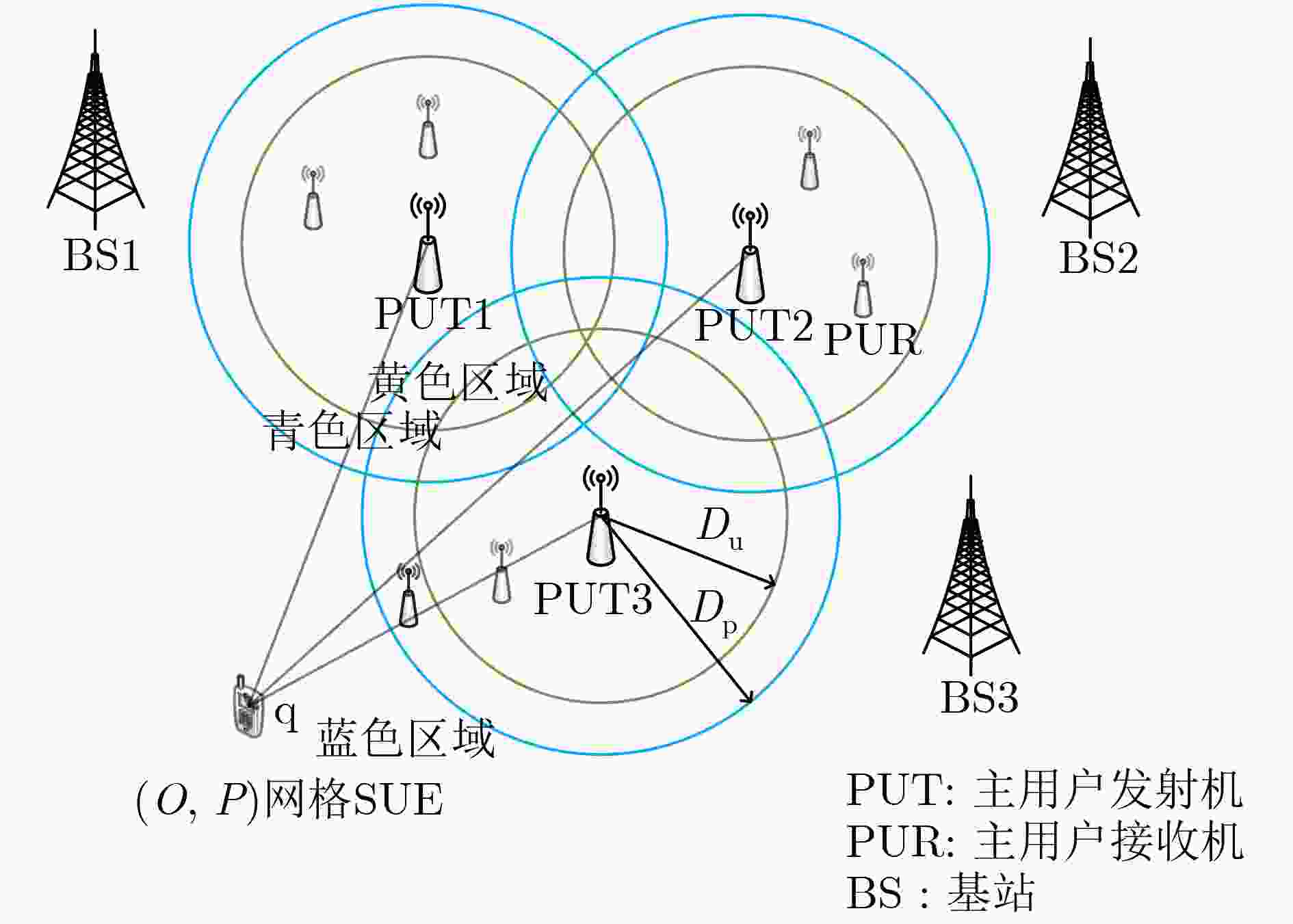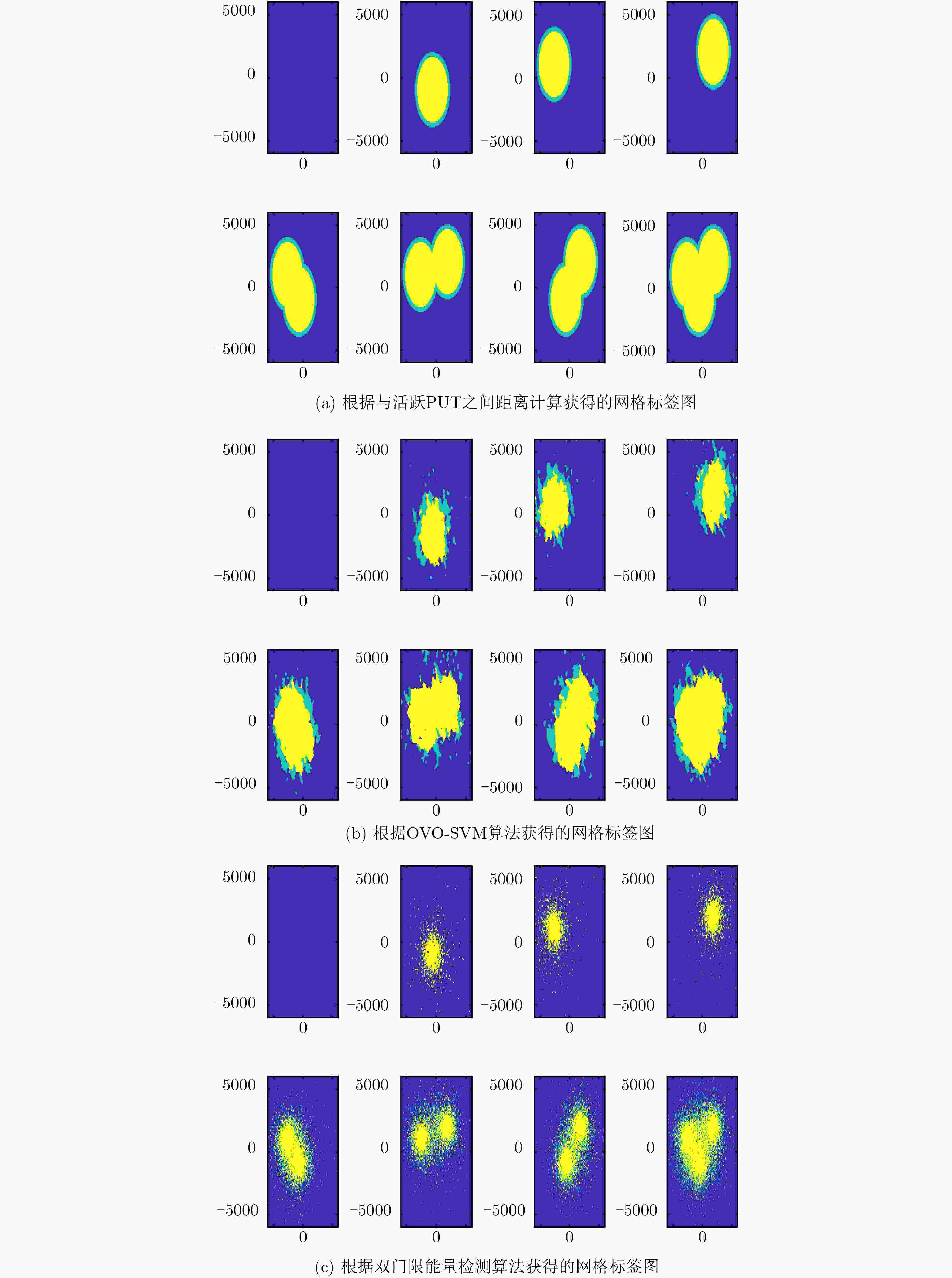Machine Learning Based Primary User Transmit Mode Classification for Spectrum Sensing in Cellular Cognitive Radio Network
-
摘要:
近年来,基于机器学习(ML)的频谱感知技术为认知无线电系统提供了新型的频谱状态监测解决方案。利用蜂窝认知无线电网络(CCRN)中的次级用户设备(SUE)所能提供的大量频谱观测数据,该文提出了一种基于主用户(PU)传输模式分类的频谱感知方案。首先,基于多种典型的ML算法,对于网络中的多个主用户发射机(PUT)的传输模式进行分类辨识,在网络整体层面上确定所有PUT的联合工作状态。然后,网络中的SUE根据其所处地理位置或者频谱观测数据,判断其在当前已判定的PUT发射模式下接入授权频谱的可能性。由于PUT在网络中的实际位置可能事先已知或者无法提前确定,该文给出了3种不同的处理方法。理论推导与实验结果表明,所提方案与传统的能量检测方案相比,不仅改善了频谱感知性能,还增加了蜂窝认知网络对于授权频谱的动态访问机会。该方案可以作为蜂窝认知无线电网络中的一种高效实用的频谱感知解决方案。
Abstract:In recent years, Machine Learning (ML) based spectrum sensing technology has provided a new solution in spectrum status identification for cognitive radio systems. Based on the large amount of spectrum observations captured by the Secondary User Equipment (SUE) in the Cellular Cognitive Radio Network (CCRN), this paper proposes a spectrum sensing scheme based on the Primary User (PU) transmission mode classification. Firstly, based on a variety of typical ML classification algorithms, the proposed scheme classifies the transmission mode of multiple Primary User Transmitters (PUTs) in the CCRN, and determines the joint operating state of all the PUTs in the CCRN. Subsequently, the SUE evaluates the possibility of accessing the licensed spectrum in the currently determined PUT transmission mode according to its geographical location or spectrum observation data. Since the actual locations of the PUTs in the network may be readily known in advance or unaware of at all, the proposed scheme solves the problem in three different methods. Theoretical derivation and experimental results show that compared with the traditional energy detection scheme, the proposed scheme not only remarkably improves the spectrum sensing performance, but also significantly increases the opportunities of dynamic accessing to the licensed spectrum for the SUEs. The proposed scheme can be used as an efficient and practical spectrum sensing solution in the CCRN.
-
算法1 基于能量值模板差值的PUT模式分类 输入:${{{Y}}_m},\widehat {{Y}},G,$阈值$\varphi $ 输出:${\hat {{S}}^{(m)} }$ 初始化 (1) ${{{y}}_{m,1} } = {\rm{vec} }({{{Y}}_m})$%矩阵转化为列向量 (2) ${{{y}}_{m,2} } = {\rm{sort} }({{{y}}_{m,1} },{\rm{descending} })$%降序排列 (3) ${\rm{ = \{ }}{Z_{{x_1},{y_1}}},{Z_{{x_2},{y_2}}}, \cdots ,{Z_{{x_Q},{y_Q}}}\} $ (4) 获取行位置索引向量 ${{x}}{\rm{ = \{ } }{x_1}{\rm{,} }{x_2}{\rm{,} } ··· {\rm{,} }{x_Q}{\rm{\} } }$及 (5) 列位置索引向量 ${{y}}{\rm{ = \{ } }{y_1}{\rm{,} }{y_2}{\rm{,} } ··· {\rm{,} }{y_Q}{\rm{\} } }$ (6) IF$({Z_{ {x_1},{y_1} } } < \varphi )\& ({Z_{ {x_2},{y_2} } } < \varphi )\& ··· \& ({Z_{ {x_G},{y_G} } } < \varphi )$ (7) ${\hat {{S}}^{(m)} } = {\mathbb{S}_0}$ (8) Else (9) For $i = 1:1:G$ (10) For $j = i + 1:1:G$ (11) If $(\left| {{x_i} - {x_j}} \right| < g)\& (\left| {{y_i} - {y_j}} \right| < g)$ (12) ${Z_{{x_j},{y_j}}} = 0$ (13) EndIF (14) EndFor (15) EndFor (16) EndIF (17) For $i = 1:1:G$ (18) ${{{h}}_{\rm{1} } }(i) = {\rm{find} }({x_i}\left| { {Z_{ {x_i},{y_i} } } \ne 0} \right.)$ (19) ${{{h}}_{\rm{2} } }(i) = {\rm{find} }({y_i}\left| { {Z_{ {x_i},{y_i} } } \ne 0} \right.)$ (20) EndFor (21) ${\varDelta _l} = \displaystyle\sum\limits_{i = 1}^{\left| { {h_1} } \right|} {|{ {{Y} }_m}({ {{h} }_1}(i),{ {{h} }_2}(i)) - { {{Y} }_l}({ {{h} }_1}(i),{ {{h} }_2}(i))|}$ (22) ${l_{ {\rm{opt} } } } = \mathop {\arg \min }\limits_{l = 1,2, \cdots ,{2^N} - 1} {\varDelta _l}$ 输出:${\hat {{S}}^{(m)} } = {\mathbb{S}_{ {l_{ {\rm{opt} } } } } }$ 注:${\rm{|} }{{{h}}_1}{\rm{|} }$为集合${{{h}}_1}$的势,即其所包含的所有元素的个数。 表 1 CNN分类算法采用的结构参数
层类型 输入尺寸 滤波器尺寸 激活函数 卷积层(1) 120×120 3×3×32 ReLu 卷积层(2) 60×60 3×3×64 ReLu 全连接层 14400×1 1024个神经元 Softmax 表 2 PUT传输功率为32 dBm时,PUT传输模式分类准确率
算法名称 数据充分性条件 11.1% 47.4% 100% 能量值模板差值 0.12 0.26 0.28 K-means 0.42 0.43 0.44 HOG+SVM_8*8 0.12 0.16 0.17 HOG+SVM_16*16 0.12 0.12 0.18 CNN 0.62 0.96 0.99 -
ALI A and HAMOUDA W. Advances on spectrum sensing for cognitive radio networks: Theory and applications[J]. IEEE Communications Surveys & Tutorials, 2017, 19(2): 1277–1304. doi: 10.1109/COMST.2016.2631080 AXELL E, LEUS G, LARSSON E G, et al. Spectrum sensing for cognitive radio: State-of-the-art and recent advances[J]. IEEE Signal Processing Magazine, 2012, 29(3): 101–116. doi: 10.1109/msp.2012.2183771 黄河, 袁超伟. 基于动态自适应双门限能量检测的序贯协作频谱感知算法[J]. 电子与信息学报, 2018, 40(5): 1037–1043. doi: 10.11999/JEIT170731HUANG He and YUAN Chaowei. A sequential cooperative spectrum sensing algorithm based on dynamic adaptive double-threshold energy detection[J]. Journal of Electronics &Information Technology, 2018, 40(5): 1037–1043. doi: 10.11999/JEIT170731 KIM J and CHOI J P. Sensing coverage-based cooperative spectrum detection in cognitive radio networks[J]. IEEE Sensors Journal, 2019, 19(13): 5325–5332. doi: 10.1109/JSEN.2019.2903408 申滨, 王志强, 青晗. 基于次用户功率控制辅助的合作频谱感知[J]. 电子与信息学报, 2018, 40(10): 2337–2344. doi: 10.11999/JEIT171232SHEN Bin, WANG Zhiqiang, and QING Han. Secondary user power control aided cooperative spectrum sensing[J]. Journal of Electronics &Information Technology, 2018, 40(10): 2337–2344. doi: 10.11999/JEIT171232 MAUWA H, BAGULA A, ZENNARO M, et al. Systematic analysis of geo-location and spectrum sensing as access methods to TV white space[J]. Journal of ICT Standardization, 2016, 4(2): 147–176. doi: 10.13052/jicts2245-800X.423 陈思吉, 王欣, 申滨. 一种基于支持向量机的认知无线电频谱感知方案[J]. 重庆邮电大学学报: 自然科学版, 2019, 31(3): 313–322. doi: 10.3979/j.issn.1673-825X.2019.03.005CHEN Siji, WANG Xin, and SHEN Bin. A support vector machine based spectrum sensing for cognitive radios[J]. Journal of Chongqing University of Posts and Telecommunications:Natural Science Edition, 2019, 31(3): 313–322. doi: 10.3979/j.issn.1673-825X.2019.03.005 THILINA K M, CHOI K W, SAQUIB N, et al. Machine learning techniques for cooperative spectrum sensing in cognitive radio networks[J]. IEEE Journal on Selected Areas in Communications, 2013, 31(11): 2209–2221. doi: 10.1109/jsac.2013.131120 AWE O P and LAMBOTHARAN S. Cooperative spectrum sensing in cognitive radio networks using multi-class support vector machine algorithms[C]. The 9th International Conference on Signal Processing and Communication Systems, Cairns, Australia, 2015: 1–7. doi: 10.1109/ICSPCS.2015.7391780. LI Zan, WU Wen, LIU Xiangli, et al. Improved cooperative spectrum sensing model based on machine learning for cognitive radio networks[J]. IET Communications, 2018, 12(19): 2485–2492. doi: 10.1049/iet-com.2018.5245 LU Yingqi, ZHU Pai, WANG Donglin, et al. Machine learning techniques with probability vector for cooperative spectrum sensing in cognitive radio networks[C]. s2016 IEEE Wireless Communications and Networking Conference, Doha, Qatar, 2016: 1–6. doi: 10.1109/WCNC.2016.7564840. CHEN Siji, SHEN Bin, WANG Xin, et al. A strong machine learning classifier and decision stumps based hybrid adaboost classification algorithm for cognitive radios[J]. Sensors, 2019, 19(23): 5077. doi: 10.3390/s19235077 WEI Zhiqing, FENG Zhiyong, ZHANG Qixun, et al. Three regions for space-time spectrum sensing and access in cognitive radio networks[C]. 2012 IEEE Global Communications Conference, Anaheim, USA, 2012: 1283–1288. doi: 10.1109/GLOCOM.2012.6503290. 阮丽华, 李勇, 程伟. 一种空时二维联合频谱感知区域划分方案[J]. 系统工程与电子技术, 2016, 38(5): 1146–1152. doi: 10.3969/j.issn.1001-506X.2016.05.27RUAN Lihau, LI Yong, and CHENG Wei. Novel region division approach for joint space-time spectrum 2-dimensions sensing in cognitive radio[J]. Systems Engineering and Electronics, 2016, 38(5): 1146–1152. doi: 10.3969/j.issn.1001-506X.2016.05.27 SINGH G and CHHABRA I. Effective and fast face recognition system using complementary OC-LBP and HOG feature descriptors with SVM classifier[J]. Journal of Information Technology Research, 2018, 11(1): 91–110. doi: 10.4018/JITR.2018010106 DADI H S, PILLUTLA G K M, and MAKKENA M L. Face recognition and human tracking using GMM, HOG and SVM in surveillance videos[J]. Annals of Data Science, 2018, 5(2): 157–179. doi: 10.1007/s40745-017-0123-2 MERCHANT K, REVAY S, STANTCHEV G, et al. Deep learning for RF device fingerprinting in cognitive communication networks[J]. IEEE Journal of Selected Topics in Signal Processing, 2018, 12(1): 160–167. doi: 10.1109/JSTSP.2018.2796446 -






 下载:
下载:





 下载:
下载:
